
Italy’s known for high fashion, but it’s also getting a name for innovative waste handling. Italy has for some time had a serious problem with disposing of it “urban organics,” also known as garbage.
Italy’s known for high fashion, but it’s also getting a name for innovative waste handling.
Italy has for some time had a serious problem with disposing of it “urban organics,” also known as garbage. Garbage disposal systems are not allowed so for the past 20
 |
|
| The Rivalta Energia Project is a cooperative formed by area farmers and entrepreneurs that uses manure and urban waste to produce biogas and compost. The facility is based in Buscoldo, Italy, and started operation in the fall of 2007.
|
years, trucks have picked up the bagged garbage and delivered it to landfills. Or they have taken the waste to facilities to be turned into biofuel. Unfortunately, at these facilities the waste stream must be sorted manually and is fraught with health issues.
“Dr. Carlo Sordelli envisioned this problem as a resource,” says Richard Miller, vice president of DODA USA. “With more than 30 years of experience in alternative energy projects, including biogas, geothermic, solar and wind, he recognized this waste stream as a powerful biogas feedstock and saw a more efficient way to utilize it.”
Dr. Sordelli’s vision also included the rural community. Farmers would be able to turn their manure into a value-added product, while producing and selling electricity.
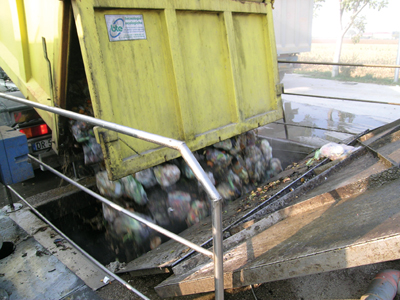 |
|
| Trucks bring bagged garbage to the facility. Submitted photo
|
Dr. Sordelli came to DODA, headquartered in Buscoldo, Italy, with his vision and challenged the company to design it. DODA, known as the “go to” company when it comes to waste management questions, took on the challenge. Their solution became the Rivalta Energia Project, which went into operation in the fall of 2007.
Rivalta Energia Project
Rivalta is a cooperative formed by area farmers and entrepreneurs, including Dr. Sordelli. The unique operation sits on about three acres near Buscoldo and is being visited by farmers and municipalities worldwide, looking to take advantage of this new technology.
The processing system is fairly straightforward.
- Step One – Trucks bring the bagged garbage and a bag opener slices open the plastic bags, releasing the contents. It also periodically reverses rotation, preventing the wrapping of bags.
- Step Two – A uniquely designed chopper pump agitates and chops the bagged contents and mixes it with digester effluent to form a thick pulp.
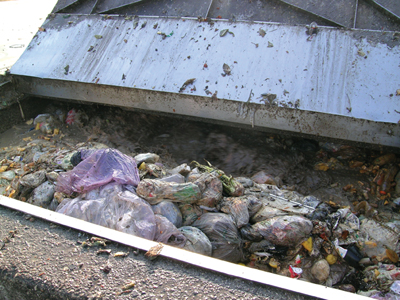 |
|
| The bagged garbage is mixed in with digester effluent. Submitted photo
|
“The pump is designed to withstand severe abuse but, on occasion, receives items such as large chunks of iron that it can’t pass,” says Miller. “The pump has a hydraulic quick removal system that allows easy access in the event repair is needed. ”
- Step Three – A specifically designed bio separator separates the contaminants (plastics, metal and other non organics) from the digestible slurry. The pulped waste from the chopper pump is pumped to the bio separator to spin the contaminants from the slurry into a dumpster that’s sent to a plastic recycler.
“The entire process is controlled by a computerized panel board to control each element of the system,” says Miller.
- Step Four – Before going to the digester, the filtered slurry goes to concrete reception pits, which are equipped with hydraulically controlled covers. Manure from 140 dairy cows is also added to the pits (also referred to as the “kitchen”). The pits can also receive silage, or other similar grasses or feed stock like greases, fats and oils.
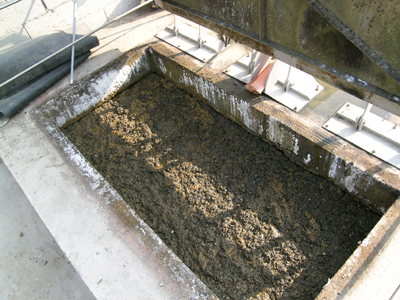 |
|
| Before going to the digester, the filtered slurry goes to concrete reception pits where manure from 140 dairy cows is added. The pits can also receive silage or feed stock like greases, fats and oils. Submitted photo
|
Odor isn’t an issue with these particular pits. They are under a vacuum, so no odors are being emitted. Also, when the pits are being agitated, air is pulled from the pit and run through a bio filter filled with wood chips to filter the air.
To make the system more efficient, DODA developed a bio box that allows the various slurries to be moved to any place in the facility by one pump and controlled by computer. “The system seems complicated but is rather simple and allows for convenience by the plant operator,” says Miller.
Digesting
The digester system requires 110 tons of substrate a day and can produce one megawatt of energy — expandable to two megawatts.
“It’s a complete mix, two-stage design and is thermophillic,” says Miller. “It operates at 51 to 52 degrees Celsius, or about 125 degrees Fahrenheit.”
There are four tanks — two for the first stage and two for the second. “The primary stage is a round concrete tank with a concrete top. Its purpose is to collect the gas that releases quickly from substrates high in sugars,” says Miller. “The retention is 12 to 15 days, and the gas production is high but lower in methane than stage two.”
The second stage digester is also a concrete tank, but utilizes a two-piece membrane top. “An outer membrane is domed and is inflated by air,” explains Miller. “The inner membrane expands and contracts with gas production and extraction.”
The substrate is retained for 25 to 30 days during this second stage. The gas production is lower but very rich in methane. In fact, Rivalta has experienced exceptional methane production — 800 cubic meters of gas per hour, containing 68 to 70 percent methane.
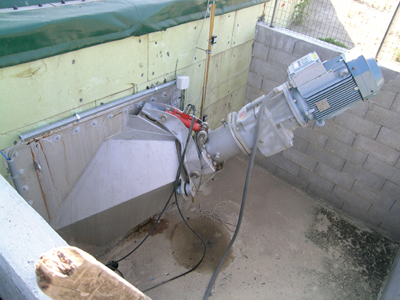 |
|
| Each digester tank is mixed periodically by biogas mixers to keep the mixture homogenized. Submitted photo
|
“The biogas produced is scrubbed and sent to generators that produce the electricity that is sent to the grid,” says Miller. “And water, used to cool the generators, supplies hot water to the heat tubes in the digester tanks.”
When Dr. Sordelli was asked why he chose a two-stage digester design, he said that two complete sets of tanks assure they will never be shut down and not be producing gas. He compared a digester to a cow’s stomach, which has four stages for more complete digestion and efficiency.
The idea behind the Rivalta Energia Project was to extract all energy possible from the substrates. Dr. Sordelli feels this system is the most efficient by far, and that following “nature” is always the best path.
Mixing it up
Each digester tank is mixed periodically by biogas mixers. Miller says that keeping the mixture homogenized is an important step. “By thorough mixing, you have consistent temperature and that keeps the ‘bugs’ happy. The mixers turn quite slowly and are installed with variable frequency drives. Experience has shown that ‘motion, not commotion’ is best in mixing substrate.”
The mixers also prevent crusting, which is important to the process and observation windows were installed by DODA in the digesters so the operators see what the waste condition is at all times.
After the substrates are done digesting, they’re sent to a holding pit, and then pumped to separators.
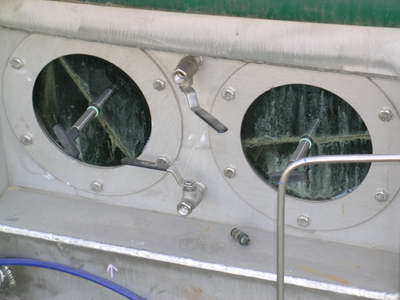 |
|
| Observation windows were installed in the digesters so operators can see what the waste condition is at all times. Submitted photo
|
The liquids from the separator are used as fertilizer and/or recycled back to the “kitchen” for mixing. “This effluent is very rich in available nitrogen as only the carbon atoms are extracted during digestion and makes great fertilizer,” says Miller. The solids are collected and composted for use as soil amendments.
Miller says that studies are being done to see if the solids can also be used to produce bio diesel through pyrolysis. In simplistic terms, the process exposes the substrate to high heat. Gases coming off the substrate contain solids that, when condensed, contain bio oil.
“The cost of this process is too expensive right now to be economically feasible,” says Miller. “But as science goes along, who knows where it will end up.”
Benefits for farmers
The benefits of the system to farmers are many. First, the facility doesn’t require many man-hours to operate — only 1,800 per year. It can be run by computers — either on site or via hand held devices.
Second, besides either selling and/or using the energy produced, farmers can expect to receive ”tipping fees” from the companies delivering the urban waste. “These fees can run as high as $100 a ton,” says Miller.
Lastly, the solids and liquids coming off the digester can be used on fields or sold to other farms.
As for the urban waste handlers, the fee to deliver the organic waste to the farmer is normally lower than the cost to have it delivered to a landfill, and is a much healthier and green environment alternative.
“There’s nothing negative about the process,” says Miller.
The only snag that has come up during the Rivalta project is that a few areas produced too much negative product (such as a large piece of steel in the waste stream) to be a candidate. But other that that, the project has been a complete success.
New operations coming on board
The Rivalta Energia Project is gaining momentum.
“Interest in this system and technology is tremendous,” says Miller. “Visitors from all over the world are coming to witness the everyday business of the Rivalta Project. When I visited in October of 2008, there were two additional plants being constructed and plans for three more in 2009. When I visited in January, plans for a total of 12 plants were in the works for 2009.”
Miller says the system is ideal for both municipal applications handling collected waste. Also, farms that don’t have enough manure to make a digester feasible but are near a metropolitan area where there’s lot of food waste coming either from individuals or food processing plants, are good candidates.
After attending trade shows and taking companies and farmers to Italy to show them first hand the operations, Miller says, “the interest in using the ‘urban organic’ waste stream is definitely hot right now.”
For more information and a free video of the Urban Organics system, contact DODA USA Inc. @ 507-375-5577